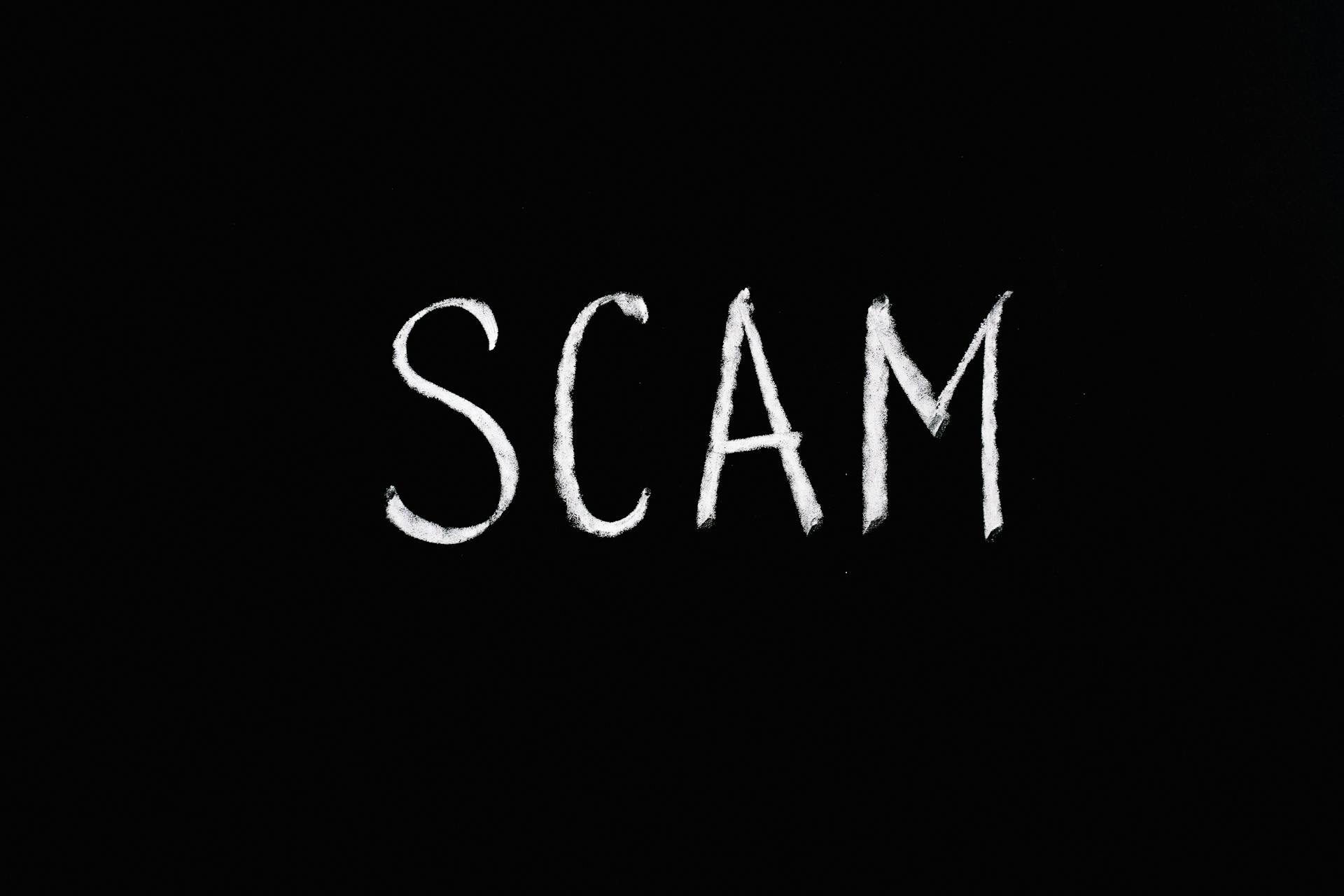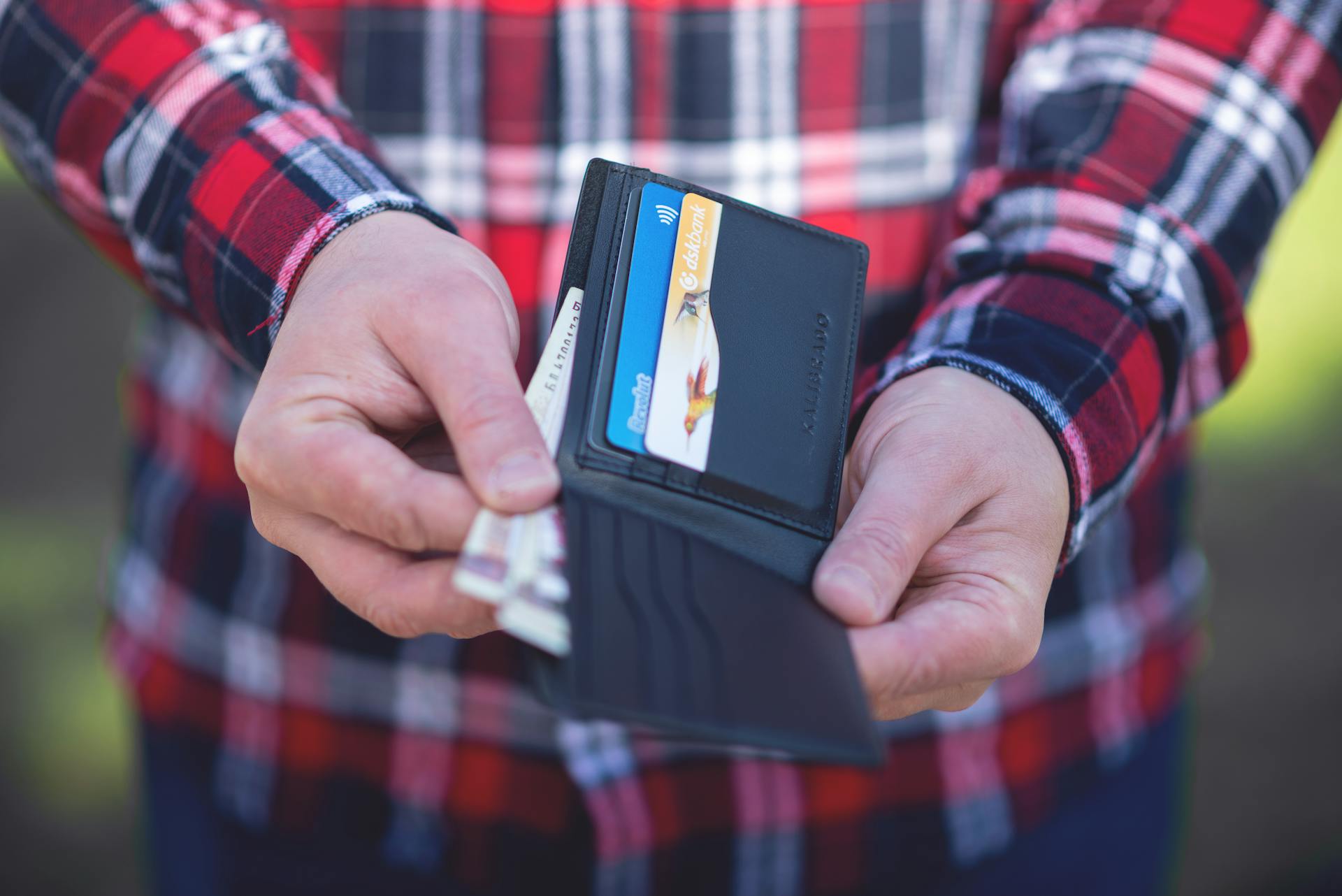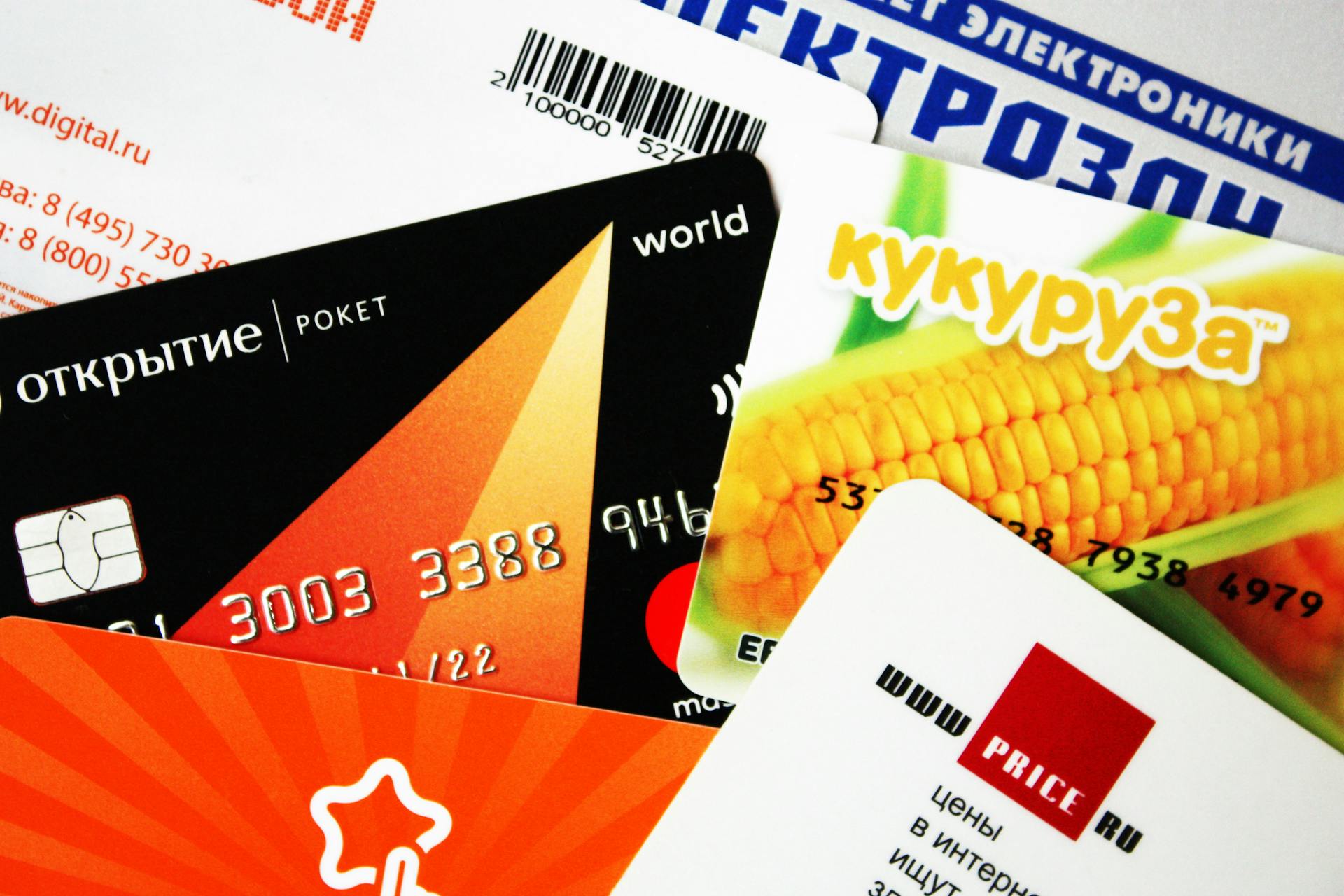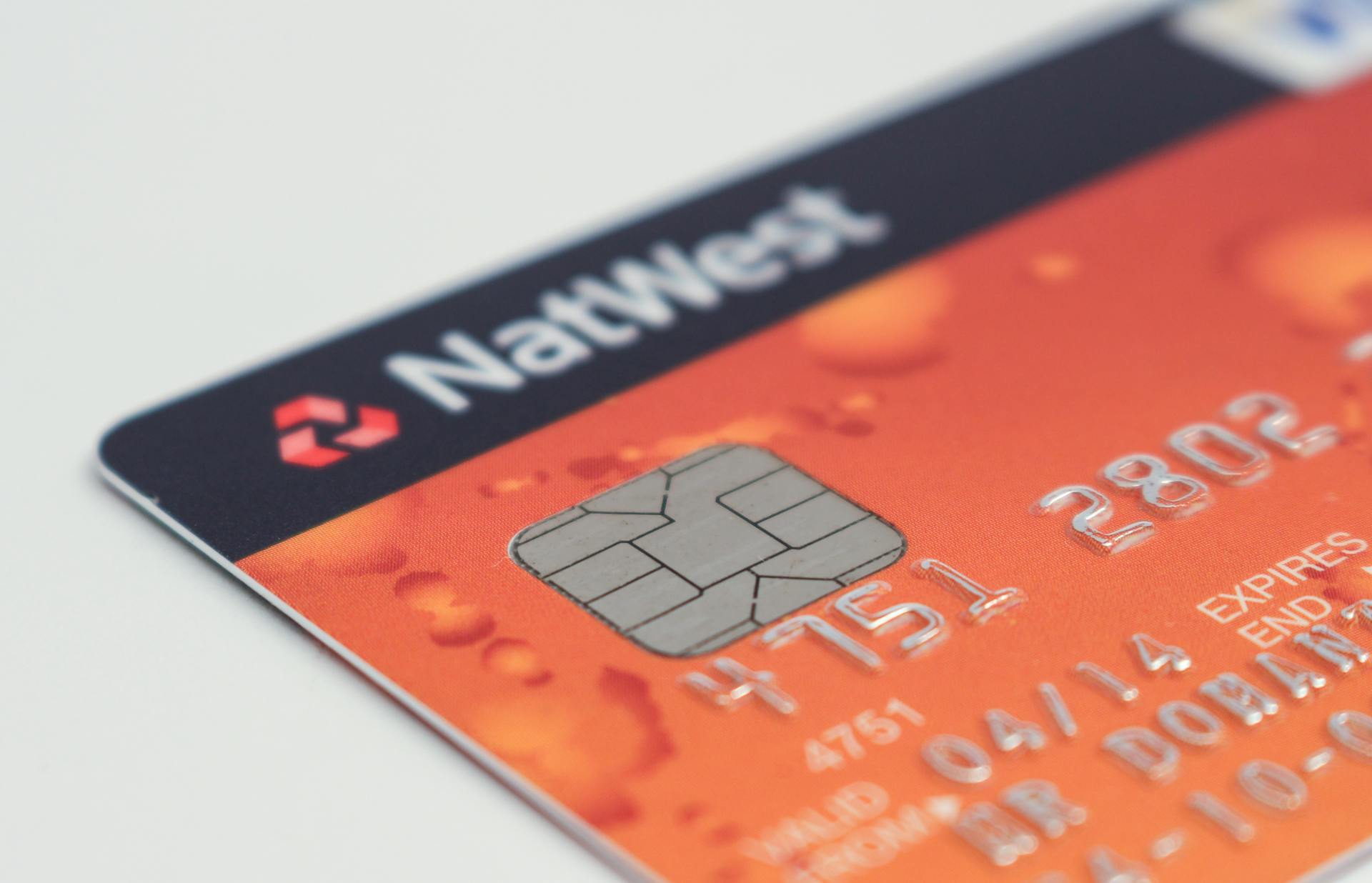
Cash card scams are a growing concern, and it's essential to understand how they work and the risks involved.
A cash card scam typically starts with a phishing email or text message, claiming to be from a legitimate company, such as a bank or a retailer, and asks you to update your account information.
The scammer's goal is to trick you into revealing your sensitive information, such as your card number, expiration date, and security code.
You should never respond to unsolicited emails or texts, especially if they ask for personal or financial information.
Cash card scams can also occur in person, where scammers might pose as representatives of a company and ask for your card details in exchange for a prize or a service.
What Is a Cash Card Scam?
A cash card scam is a type of financial fraud that targets individuals who use prepaid debit cards or cash cards. These cards are often used for online transactions, bill payments, or as a way to receive government benefits.
Curious to learn more? Check out: Tarjetas De Credito De Chase
Victims of cash card scams typically receive a call or email claiming to be from a legitimate company, such as a bank or government agency, and are asked to provide their card information or PIN.
Cash card scams can be committed by individuals or groups, and can result in significant financial losses for the victim.
Types of Cash Card Scams
There are several types of cash card scams that you should be aware of.
Prepaid card scams involve using stolen or fake prepaid cards to make purchases online or in-person.
ATM scams often involve using a stolen or cloned card to withdraw cash from an ATM.
Card skimming scams occur when a thief attaches a device to an ATM or payment terminal to steal card information.
For more insights, see: Cash Transfer from Debit Card
How It Works
Card cloning is a type of cash card scam where thieves create a fake card with your information. This is often done by installing a skimmer, a device that reads and copies card information, in an ATM or point-of-sale terminal.
The skimmer is designed to secretly read and copy card information as you use the ATM or POS device. This can happen even if you're just trying to withdraw cash or make a purchase.
There are different ways payment cards store and transmit information, which is why the tools and methods used to clone cards can vary. This means that card cloning can happen in different situations and with different types of cards.
The most common form of card cloning is called "skimming" and it involves installing a skimmer in an ATM or POS device. This is how card cloning works in a technical sense: a customer's card is fed through the card reader on the ATM or POS device, and the skimmer copies the card's information.
Here's a step-by-step breakdown of how card cloning works:
- Criminals install a skimmer in an ATM or POS device.
- A customer's card is fed through the card reader on the ATM or POS device, and the skimmer copies the card's information.
- The criminals retrieve the information copied by the skimmer.
- The criminals can then use the stolen information to commit fraud, copy it to a fabricated or stolen card, and/or sell it on the black market.
Emv Chip
An EMV chip is a microchip installed in newer payment cards that dynamically encrypts each transaction made with the card.
This makes it difficult for thieves to access the actual authorization information, even if they attempt to clone the card.
Thieves have developed devices called "shimmers" that operate in much the same way as skimmers, but work on cards with EMV chips.
These shimmers can bypass the security provided by the EMV chip and still allow thieves to clone the card.
Thieves have also figured out how to transfer the digital information on an EMV chip to an analog magnetic strip, effectively cloning the card.
Common Risks and Prevention
Prepaid card scams are on the rise, with the global market for transactions involving prepaid cards reaching $3.65 trillion in 2023. Merchants who accept credit cards are vulnerable to disputes resulting from the theft or misuse of prepaid cards.
Merchants in regions or markets that already deal in a high volume of prepaid card transactions may already have firsthand experience dealing with these issues. Analyzing your chargeback data can tell you if prepaid card scams are a problem for your business.
Purchases made with prepaid cards can lack accurate or detailed cardholder information, making it difficult for merchants to detect fraud. Imposing daily spending limits and setting a cooldown period after a purchase can help prevent scammers from immediately cashing out stolen funds.
Related reading: Is a Cash App Card a Prepaid Card
Empty

The global market for transactions involving prepaid cards reached $3.65 trillion in 2023, making it a popular payment option. This popularity has led to a rise in prepaid card scams, which can affect both consumers and merchants.
In 2019, there were 38,000 reported cases of crime in the U.S. that involved the use of prepaid cards, with combined losses totaling $103 million. Hackers are exploiting prepaid card systems by compromising databases and copying card numbers.
Prepaid cards can be easily obtained, loaded, drained, and exchanged on the dark web, making them a popular vehicle for fraud. This ease of use also makes it difficult for merchants to track prepaid card transactions.
Purchases made with prepaid cards often lack accurate or detailed cardholder information, making it hard for merchants to detect fraud. Without a defined origin point for shipping and tracking, or other pertinent details, merchants are left with limited options to prevent scams.
In 2019, law enforcement agencies reported that prepaid cards were used in drug trafficking operations and in preparation for terrorist attacks. The versatility and freedom offered by prepaid cards make them appealing to both consumers and fraudsters.
Intriguing read: Cash for Credit Cards
10 Common Risks and Risk Reduction Tips

Prepaid card scams are a growing problem, with the global market for transactions involving prepaid cards reaching $3.65 trillion in 2023. One way to reduce your exposure is to be aware of the top 10 prepaid card scams to watch out for, including gift card scams, where fraudsters use spoofed phone numbers and voice changers to trick victims into paying with prepaid cards.
Merchants can avoid prepaid card scams by addressing potential weaknesses in their business practices, such as limiting value amounts on prepaid cards to make them less attractive to scammers. Limiting value amounts may make your cards less attractive to scammers, as it's simpler to convert one $500 prepaid card to cash than a stack of $50 cards.
To quickly detect and respond to card cloning fraud, merchants should equip their risk and compliance teams with a transaction monitoring solution. This can help prevent card cloning by analyzing customer behavior and securing vulnerable contact points.
Related reading: Can U Use a Prepaid Card on Cash App

Card cloning fraud can't be stopped by new security technology alone, so it's essential to educate consumers, analyze customer behavior, and secure physical infrastructure. Merchants can help make it more challenging for criminals to clone cards by ensuring that POS terminals are EMV compliant and helping customers purchase things in a more secure manner.
Merchants can also limit prepaid card sales, which may reduce the likelihood of prepaid card fraud. Applying a gift card redemption cooldown period can also help prevent scammers from immediately cashing out stolen funds, giving merchants and cardholders a window of opportunity to monitor transactions and report fraud.
Scammers often try to use the entire balance of a stolen card in one go, so setting daily purchasing limits can help prevent this. Contactless tap payments can also help avoid skimmers and shimmers, but they're not without their vulnerabilities, as criminals have developed RFID-enabled card cloning devices.
Merchants can also take steps to prevent card cloning by reviewing their transaction infrastructure and securing points of sale, such as ATMs and point-of-sale machines. This can make it more difficult for criminals to clone cards, and by combining customer profile data, securing physical infrastructure, and using EMV chips, merchants can be more confident that the cards being used are legitimate.
If this caught your attention, see: Apple Card 3 Cash Back Merchants
What to Do

To prevent common risks, you should have a plan in place for unexpected events, such as having a fire evacuation route and a first aid kit on hand.
Regularly inspecting your home can help identify potential hazards, like faulty electrical outlets or loose floorboards, which can be fixed before they cause an accident.
Stay informed about weather conditions and follow evacuation orders if necessary, especially if you live in a flood-prone area.
Make sure to keep emergency contact numbers, such as the fire department and poison control, easily accessible.
Conduct regular safety checks on your appliances and electronics to prevent electrical fires and other hazards.
Keep a list of important phone numbers and documents, such as insurance policies and identification, in a safe and accessible place.
Preventing Cloning
Card cloning is a type of fraud that's increasingly common, with over 440 billion purchase transactions worldwide in 2019 being potential targets.
Unfortunately, it's likely impossible to eradicate card cloning fraud, so a comprehensive risk management strategy is the best approach to preventing it.
To start, be aware of your surroundings when using your card, especially in crowded or tourist areas where thieves may be lurking.
Expand your knowledge: Apple Cash Fraud Scam
Employee
Employee fraud can be a significant threat to businesses, as dishonest employees may abuse their authority to activate prepaid cards for their own benefit.
Dishonest employees can transfer prepaid card balances to different cards to cover up the fraud, or create fake invoices to conceal unauthorized purchases.
In some cases, employees may work with third parties to return goods purchased with stolen funds, making it even harder to detect the fraud.
Employees can also defraud buyers directly by overcharging customers for purchases or stealing card information from legitimate cardholders.
On a similar theme: Credit Cards or Card
Preventing Cloning
Card cloning is a type of fraud that can happen to anyone, making it essential to take preventive measures.
Over 440 billion purchase transactions worldwide in 2019 involved the top 6 credit card brands, making these cards attractive targets for criminals.
To prevent card cloning, it's crucial to be aware of your surroundings when using ATMs or POS terminals.
Criminals often use skimmers to steal credit card information, so it's a good idea to check the card reader for any signs of tampering.
You can also prevent card cloning by regularly monitoring your financial statements and bank accounts.
If you notice any suspicious transactions, contact your bank immediately to report the issue.
Card cloning can happen even with the most current security standards, making a comprehensive risk management strategy essential.
By being vigilant and taking preventive measures, you can significantly reduce the risk of falling victim to card cloning.
Skimming and Swapping
Card skimming is a scam where a fraudster preloads a gift card or prepaid card with stolen data, and when an unsuspecting consumer buys and activates the card, the fraudster steals the card number and uses those funds to make purchases or drain the account.
Prepaid cards are increasingly popular, with market transactions expected to hit $14.4 trillion in volume by 2032.
Card swapping involves a scammer stealing a stack of physical cards, copying or altering the numbers, and then returning the cards to the store to be re-hung on the rack.
Worth a look: Cash to Card Locations
Tampering
Criminals can tamper with prepaid cards by reusing them after they've been spent, then selling them to unsuspecting consumers.
Some scammers apply fake magnetic stripes or numbers to blank plastic cards to create fake cards, which can be used to make unauthorized purchases.
Fraudsters may also install hidden cameras near ATMs to record victims' PINs, or use fake keypads to capture key presses.
Tampered prepaid cards can have a $0 balance, leaving consumers unable to use them.
Criminals may use tampered cards to make fraudulent purchases or steal money from bank accounts.
Skimming
Skimming is a sneaky way for scammers to get your card information. They use devices called skimmers to capture your card details when you swipe or insert your card at an ATM, gas pump, or store.
ATM skimming is one of the most common types of skimming. Scammers place a skimmer over the original card reader, making it hard to detect. They might also install a hidden camera or fake keypad to record your PIN.
A unique perspective: Atm Cash Card
Fraudsters often target ATMs at banks, convenience stores, or other public places. They might install a skimmer inside the terminal or along the exposed wiring. To avoid getting scammed, it's a good idea to inspect the ATM before using it.
Fuel pump skimming is another type of skimming. Scammers install a skimmer inside the payment processing machine, making it hard to detect. Paying with cash at the store attendant might be a safer option.
Most payment cards have a magnetic strip that stores and transmits analog transaction information. Unfortunately, this method offers no encoding protection, making it easy to clone magstripe-only cards using a skimming machine.
You might enjoy: Using Cash vs Card Psychology
Swapping
Swapping is a sneaky way scammers steal from you. They'll steal a stack of physical cards, copy or alter the numbers, and then return them to the store.
A recent report from Allied Market Research predicts that prepaid card market transactions will hit $14.4 trillion in volume by 2032. This is a staggering amount, and it highlights just how popular prepaid cards are becoming.
On a similar theme: 626 Night Market Cash or Card
Prepaid cards are a convenient way to pay, but they can also be a target for scammers. They're easy to steal and alter, making them a favorite among thieves.
If you're using prepaid cards, be sure to keep a close eye on them. Don't leave them unattended, and always check the numbers before loading cash onto them.
Impact on Merchants
Prepaid card scams can have a significant impact on merchants. Merchants who issue or accept prepaid cards are victims of fraud, experiencing losses in revenue, merchandise, and reputation.
They experience lost revenue due to upfront losses or post-transaction fraud, which can result in chargebacks and fees. Merchants may lose out on revenue, merchandise, and incur chargeback fees that range between $20 to $100 per dispute.
Merchants may also have to hire staff to investigate fraud claims, pay for fraud prevention tools, or spend more on advertising to counteract their damaged reputations.
A unique perspective: Creditone Bank Fraud
Disrupted Business Operations
Fraud comes with opportunity costs, and merchants have to spend significant time and resources investigating fraud cases.
Merchants have to spend time investigating fraud cases, which means they have less time to devote to revenue-generating activities such as product development initiatives.
Fighting prepaid card chargebacks also takes up a lot of time and resources, and merchants may have to hire staff to investigate fraud claims.
Merchants may also have to pay for fraud prevention tools or spend more on advertising to counteract their damaged reputations.
The National Retail Federation reported that merchants lost $101 billion to return fraud in 2023, and this number is expected to increase to $343 billion by 2027.
Readers also liked: What Time Does Ebt Cash Benefits Go on Card
Merchants Can Avoid
Merchants can avoid prepaid card scams by making a few adjustments to their business practices. Limiting prepaid card sales can reduce the likelihood of fraud by imposing reasonable limitations on purchases.
Merchants who issue or accept prepaid cards are victims of fraud, experiencing financial losses and administrative burdens. The Federal Trade Commission reports that fraud involving gift cards made up $217 million out of the $10 billion lost to scams in 2023 alone.
Prepaid card fraud can be tracked by analyzing chargeback data, which can help identify the sources of your chargebacks and the types of cards involved. This can help you stay a step ahead of the fraudsters and implement changes and policies that will make it harder for them to target you.
Scammers often try to use the entire balance of a stolen card in one go, then disappear. Imposing daily spending limits helps prevent this.
Merchants can also benefit from expert advice from chargeback specialists if they're having trouble analyzing their data or executing an effective anti-fraud strategy.
Frequently Asked Questions
Is the Cash App card in the mail a scam?
Receiving an unsolicited Cash App debit card in the mail is likely a scam, as it's often used to steal your personal info. Be cautious and don't download the app or scan any QR codes without verifying the card's authenticity
Why did Cash App send me a cash card?
Cash App sent you a cash card as a precautionary measure due to a potential data breach that may have exposed your information online. Contact Cash App directly to learn more and secure your identity.
What to do if someone is using my cash card?
Contact your bank or card issuer immediately to report unauthorized transactions and request a card block or freeze
Sources
Featured Images: pexels.com


